|
International Perspectives - December 13, 1999
Anne D. Picker
International Economist, Econoday
Growth accelerates in Europe but sags in Japan
Financial Markets
Equity markets in Europe and Asia continued to set new records. The Paris CAC set its 33rd new high for the year while the Hong Kong Hang Seng rocketed up 540 points on the week. Optimism about growth abounds in Asia and Europe. The exuberance extends to the Canadian Toronto Stock Exchange 300 index and the Mexican Bolsa as well...
| Selected World Stock Market Indexes |
| Index | 10-Dec | 1999
High | 1999
Low | Week %
Change |
|---|
| Asia |
| Australia | All Ordinaries | 3120.30 | 3145.20 | 2804.80 | 1.09 |
| Japan | Nikkei 225 | 18271.85 | 18914.50 | 13232.70 | -0.52 |
| Hong Kong | Hang Seng | 16380.21 | 15840.41 | 9076.33 | 3.41 |
| S. Korea | Korea Composite | 1018.17 | 1027.93 | 498.42 | 5.34 |
| Singapore | Straits Times | 2395.44 | 2235.82 | 1286.56 | 7.52 |
| Europe |
| Britain | FTSE 100 | 6739.50 | 6742.20 | 5770.20 | -0.04 |
| France | CAC |
5481.10 | 5468.05 | 3958.70 | 0.24 |
| Germany | XETRA DAX | 6097.90 | 6119.17 | 4668.50 | -0.35 |
| North America |
| United States | Dow | 11224.70 | 11286.18 | 9120.70 | -0.54 |
| Canada | TSE Composite 300 | 7954.59 | 7954.59 | 6180.30 | 2.05 |
| Mexico | Bolsa |
6781.39 | 6781.39 | 3300.42 | 4.81 |
Equities
Europe
Both the London FTSE and German DAX ended the week lower, in spite of a renewed wave of optimism about technology stocks. The FTSE edged down 2.7 points on the week to 6739.5 while the DAX was down 21.27 points at 6097.9. The DAX was roiled by merger activity as sentiment about them swayed and profit taking emerged.
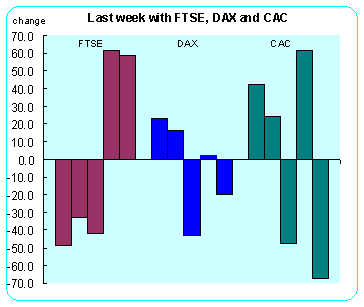
The Paris CAC closed above 5,500 for the first time Tuesday. The index sank below 5500 on Friday and ended the week at 5481, up 13 points. The CAC scored its 32nd and 33rd record closes during last week, with technology stocks spearheading the increase. Although the index did not end the week above the 5500 mark, it continues to make history.
The FTSE was erratic as investors nervously awaited the outcome of the Bank of England Monetary Policy Committee meeting on Thursday. The FTSE was down the first three days of the week and barely failed to get even in the relief rally that followed the Bank of England announcement of no rate increase. Although a rate increase was not expected because of the approach of Y2K, based on the new economic data available, the decision could have gone either way.
Asia
Equities
The Hong Kong Hang Seng index vaulted 540 points last week to close at 16380 - its highest point in almost 28 months. Growing optimism that the territory's economic recovery would gain further momentum and help boost corporate earnings buoyed the index. The index was helped by substantially better than expected 4.5 per cent growth in third quarter gross domestic product. The bilateral agreement signed by China and the United States, to pave the way for China to enter the World Trade Organization, further brightened prospects for many Hong Kong companies doing business on the mainland. Exuberance was muted on Friday when investors became concerned about possible inflationary trends in the United States prior to the producer prices indexes release.
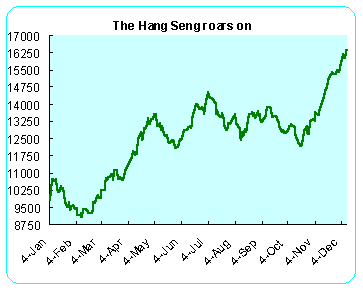
The Singapore Straits Times index rose sharply led by blue chips generally, and banking stocks in particular. The index jumped 167 points on the week to close at 2395.44. The index rose on active foreign and local buying.
The Nikkei lost ground on the week, closing down 96 points at 18271.85. A disappointing GDP report on Monday dented market optimism. Towards the end of the week, investors became edgy in advance of the Bank of Japan's quarterly business confidence survey, the Tankan, due out today.
South Korean stocks wavered during the week as foreign investors took profits when the index surged over 1,000. Market participants said news that foreign creditors would be reluctant to accept debt workout programs for Daewoo contributed to the downward trend. Technology stocks, which have been riding high on the recent gains on Nasdaq, saw some profit taking. However, on Friday, the index jumped 38 points to finally close over 1000 amid relief that Thursday's futures and options contracts expired with little effect on the market.
Currencies
Euro
While good economic data helped the euro at the beginning of the week, good data at the end of the week had less of an impact. The euro posted its biggest gain yet against the dollar as a stronger than expected German manufacturing report boosted growth expectations. The rally took the euro over two cents higher against the dollar and nearly four yen up against the Japanese currency. It left the euro a long way away from the parity level where it had been hovering for several days. Investor confidence was also buoyed by news that the European jobless rate had dipped to 9.9 per cent in October. The unemployment rate was below 10 per cent for the first time in seven years.
However, the euro again struggled to gain strength from positive German data on Wednesday, but failed. Analysts said that fears over a leftward shift in German politics could limit the upside for the euro. Contributing to the euro's malaise were comments by an European Central Bank official that supported the view that the ECB isn't concerned enough by the currency's drop to intervene to arrest the fall. These remarks accelerated the euro's decline and helped halt a three day rally that carried the currency from record lows.
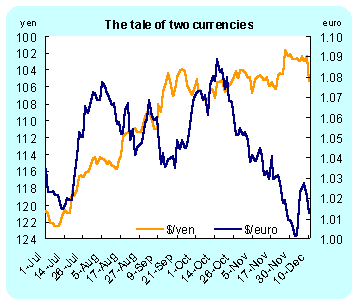
Yen
The yen fell against the dollar when ambiguous gross domestic product data showed that the economy unexpectedly contracted in the third quarter. However, growth in the previous quarter was revised up sharply. The strong yen has not yet had any identifiable negative impact on the Japanese economy or its outlook, according to Sakuya Fujiwara, deputy governor of the Bank of Japan. So far the negative impact of the yen's appreciation on exports has been mitigated by the recovery of overseas economies.
Investors are looking to the quarterly Tankan business sentiment survey, scheduled for release Monday, for further clues to the economy's direction. The survey gives us a snapshot of what's going on, and the state of Japan's economy is important to the exchange rate. The yen could get a boost if the survey shows a leap in optimism.
Central Banks
With the Federal Reserve Open Market Committee meeting looming on December 21st, market participants were watching the results of the Bank of England Monetary Policy Committee meeting outcome closely. As in the United States, the British economy has been growing rapidly with low inflation despite low unemployment.
The Bank of England leaves rates alone...
The Bank of England left interest rates unchanged as expected. The Bank's Monetary Policy Committee (MPC) recommended that the base rate - the short-term rate at which the Bank will lend to other financial institutions - at 5.5 percent. The base rate sets the level of interest rates for business and personal borrowing. The MPC had increased rates by 25 basis points in September and again in November. The major deterrent to an increase was Y2K. However, a case could have been made to either raise interest rates or keep stable based on recently released economic indicators. Many analysts expect to see it rise further to about 6 percent early next year.
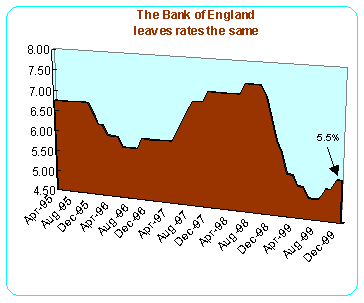
A major concern to the MPC had been soaring house prices. However, the Halifax survey which was released last week saw prices decline, albeit for just one month. However, this may suggest that the two interest rate boosts in September and November may have had their desired effect on property prices.
Another reason that might have helped persuade the Committee to leave rates alone is the strength of the pound. On a trade weighted basis, the pound is now about one percent higher than assumed in the MPC's November Inflation Report.
The primary goal of the nine member Monetary Policy Committee is to keep inflation close to the government's target rate of 2.5 percent as measured by the retail price index less mortgages (RPIX). The committee recommends raising rates if it thinks future inflation is on course to go over that target and reducing them if it thinks inflation is likely to undershoot. The decision making process is complicated by the fact that it takes about two years for rate changes to have their full impact on inflation. With the RPIX at 2.2 percent, many in industry and the unions had been arguing that no further rise was justified. New data on inflation will be released on Tuesday.
Indicator scoreboard...
EMU
November's economic sentiment index rose strongly, with both industrial and consumer confidence improving on the month. The overall economic sentiment index stood at 105.0 in November, after an unrevised 104.3 reading in October and 103.7 in September. All components of the index rose, with the strongest gain in construction sentiment. In addition, retail sentiment remained unchanged, although it is not included in the overall economic sentiment index.
The current account surplus of both the 15 member nations of the European Union and the 11 members of European Monetary Union declined in the third quarter of 1999 when compared with the third quarter of 1998.
Third quarter gross domestic product expanded by one percent from a quarter earlier and 2.3 percent when compared with a year earlier. The strong third quarter result was mainly due to acceleration in private consumption as well as gross fixed capital formation. While exports positively influenced third quarter GDP, slower inventory accumulation had a negative impact on third quarter GDP.
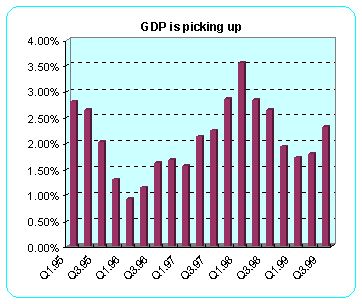
The seasonally adjusted unemployment rate fell below 10 percent for the first time since December 1992. The unemployment rate fell to 9.9 percent in October from 10 percent in September. This confirms that the European labor market is starting to benefit from the economic upswing. The unemployment rates during October improved or remained the same in all nine states reporting data. Spain showed the highest unemployment rate in October, at 15.3 percent, followed by France (10.6 percent), Finland (10 percent), Germany (9.1 percent) and Belgium (8.9 percent). Luxembourg showed the lowest unemployment rate in October, at 2.7 percent, followed by Austria (4.2 percent), Portugal (4.6 percent), and Ireland (6.2 percent).
Germany
October industrial production climbed 1.7 percent on the month, led by strong gains in manufacturing (up 2.0 percent) and construction (up 1.0 percent). East German industrial output also rose, by 1.3 percent. These data add to other recent strong key figures indicating the economy is on a clear upward trend.
October seasonally adjusted manufacturing orders rose 3.2 percent after an upwardly revised 4.2 percent decline in September, confirming that the unexpected September drop was just a one month slip and that the upward trend in orders is still intact. Latest data was positive across the board. A 6.6 percent rise in capital goods orders are a particular good sign for industrial production in the future.
Seasonally adjusted third quarter gross domestic product increased 0.7 percent on the quarter and 1.3 percent on the year. Both first and second quarter GDP were revised upward. Details indicate that consumer spending, government spending and investment showed a strong rebound in the third quarter after falling off in the second quarter. In addition, net exports continued to accelerate, contributing to third quarter growth. Only the inventory change had a negative contribution although the deceleration in stock growth suggests production will have to be boosted to meet stronger demand.
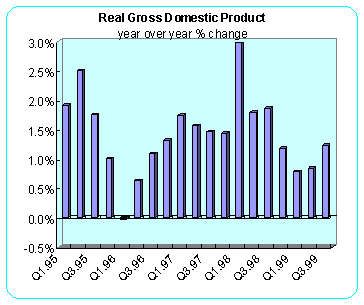
November seasonally adjusted unemployment declined more than expected for the second month in a row. East German unemployment declined for the first time since February of this year. In recent months, east German joblessness has continued to rise even as that in the west has dropped.
The October seasonally adjusted trade balance surplus stood at 5.4 billion euros. Exports, adjusted for seasonal variations but not for price differences, were down 1.4 percent on the month but up 5.8 percent from a year earlier. Imports were down 0.5 percent on the month but up 6.1 percent on the year.
Britain
October manufacturing output crept up 0.1 percent on the month and 1.3 percent on the year as the recovery in the manufacturing sector continued to take hold. The trend rate of growth is now seen at its highest since January 1995. Total October industrial production was up by 0.2 percent on the month and was up 1.5 percent on the year. Total production in the three months to October rose 1.0 percent on the quarter and was up 1.1 percent on the same three months a year ago.
Asia
Japan
Third quarter real gross domestic product dropped 1.0 percent and 3.8 percent on the year. All final private sector domestic demand components of GDP were lower. Overall domestic demand was down 1.3 percent on the quarter. However, second quarter GDP was revised up sharply to an increase of one percent on the quarter from 0.1 percent previously. Analysts noted that recent data show that private sector demand has failed to recover after the fall in public sector stimulus. The clear message from the report is that the economy remains extremely vulnerable to a slowing of public spending or weakening export demand
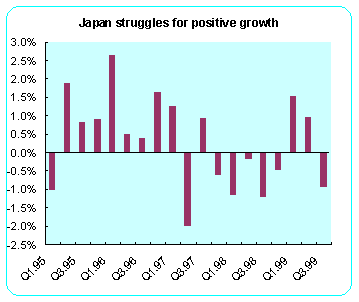
November domestic wholesale price index was unchanged from the previous month but fell 0.6 percent on the previous year. The export price index rose 0.2 percent on the month in terms of contract currencies and was down 0.7 percent in yen terms. On the year, export prices were down 8.0 percent in terms of the yen, reflecting the rise of the yen over the year. The import price index rose 0.8 percent in terms of contract currencies on the month and was down 0.2 percent in yen terms. On the year, the index was down 2.8 percent in terms of the yen.
Americas
Canada
Third quarter capacity utilization jumped 1.8 points to 86.0 percent, the highest operating rate since a peak of 86.8 percent during the 1987-88 economic expansion. Increases in capacity use were propelled by strong foreign demand, rising 3.6 points when compared with a year ago.
Recap...
The spate of positive economic indicators for the European Monetary Union, and Germany in particular should provide encouragement to investors in these markets. While the political situation, especially in Germany is making some investors uneasy, the economic evidence should help to dispel some of the fears. Stronger growth should provide the leeway necessary for policy makers to make the structural changes necessary to ensure continued growth. This would take some of the pressures off of the European Central Bank.
Looking Ahead
|
Central Bank Activities |
| Dec 15 | EMU | European Central Bank Governing Council Meeting |
| Dec 18 | Japan | Bank of Japan Monetary Policy Meeting |
|
The following indicators will be released this week... |
| Europe | | |
| Dec 13 | Germany | Final Consumer Price Index (November) |
| | Retail Sales (October) |
| UK | Producer Input and Output Prices (November) |
| Dec 14 | UK | Retail Price Indexes (November) |
| Italy | Industrial Production (September) |
| EU | Industrial Producer Price Indexes (October) |
| Germany | Ifo Business Sentiment (November) |
| Dec 15 | UK | Claimant Count Unemployment (November) |
| Germany | Wholesale Prices (November) |
| Dec 16 | UK | Retail Sales (November) |
| Dec 17 | Italy | Consumer Price Index (November) |
| France | Trade Balance (October) |
| Asia | | |
| Dec 13 | Japan | Tankan Survey (4Q, 1999) |
| Dec 15 | Australia | Gross Domestic Product (Q3, 1999) |
| Japan | Industrial Production (October) |
| Americas | | |
| Dec 13 | Mexico | Industrial Production (October) |
| Dec 15 | Canada | Survey of Manufacturing (October) |
| Dec 16 | Canada | Merchandise Trade (October) |
| Dec 17 | Canada | Consumer Price Index (November) |
| | Wholesale Trade (October) |
Release dates are subject to change.
For U.S. data releases, see this week's Simply Economics.
|








